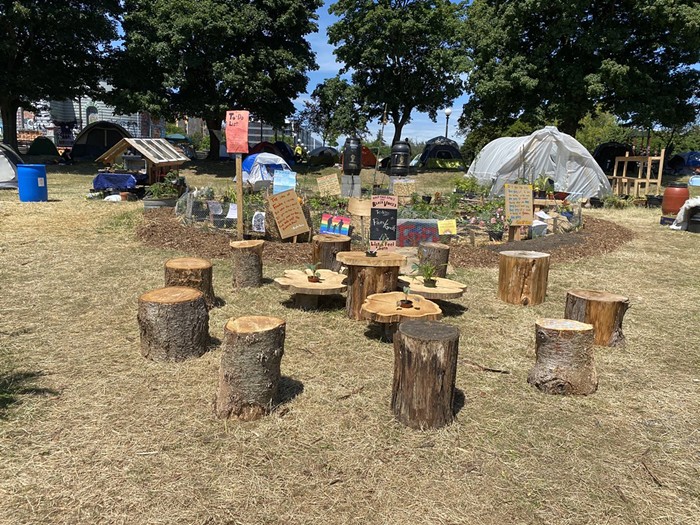
On Wednesday evening and Thursday afternoon, the beginning of a series of public hearings/Zoom meetings took place concerning the 2020 Cal Anderson Park Project, a project put forth by the Seattle Parks and Recreation Department along with HBB Landscape Architecture and DLR Group.
The goal of the project is to redesign and enhance a "sense of belonging in the park," centering BIPOC and queer community members. The points of discussion yesterday and this morning mainly focused around gaging public interest in permanent incorporation of park features birthed from CHOP—namely the community garden, a space for protest art, and a version of Decolonization Conversation Café that popped up on 11th.
"The protests of the last couple months have required that we begin a conversation about how Cal Anderson can better serve the community and more firmly speak to our values," said Andy Sheffer of the Parks Department yesterday. "The 2020 Cal Anderson Project is about receiving ideas, developing ideas, and piloting ideas for new programming elements."
There is a "three-part process" to the 2020 Cal Anderson Park Project that will stretch across three months. This month's meetings were about collecting ideas from the community. The second set of meetings in September will be based around testing the "viability" of ideas based on site constraints, opportunity, and interest. And finally, in October, the discussion will be centered around "potential implementation" of pilot projects and what the longer term would look like.
In between all of that, the team will be doing in-person surveys at Cal Anderson, conducting interviews, and hosting small site discussion groups to collect more public feedback about the project. Sheffer said any pilot projects that come out of this series of meetings will go into a "participatory design process" that they plan on carrying out in late October or November. The Seattle Process, indeed.
Marcus Henderson, the urban farmer who helped establish the community gardens in the park, was there at the meetings and spoke to the importance of CHOP's garden. He brought up the gentrification and loss of culture in Capitol Hill, mainly brought about by big tech companies like Amazon. CHOP, he says, was part of bringing that culture back into the Cal Anderson, but wants the project to think about the bigger picture when it comes to the redesign.
"Every day I had to interact with the homeless community, with people who were going through mental illness, and the garden gave me a platform in which to engage them that was healthy," he said. "So as we think about this space, I want to remind people of the services that are needed for people who have been gentrified and forced out and can’t afford housing in that area, but are the culture, are the history of Cal Anderson."
Many of the points brought up in the public comment section were centered around the community garden—how much space it takes up, the *actual* space it takes up, the security of the garden, who and how it can be accessed, whether it can be moved so the space it currently occupies can host movie nights and markets like it had in the past.
"What's happening in this movement is that a lot of individuals who have not previously felt discomfort are feeling discomfort because we need to shift the way in which our world works," said Henderson in response to these concerns. "What we're trying to do is open avenues and access to people who previously did not have access to the space and to resources and funds. We're trying to shift the way people think here and this is a part of this process."
Other questions that were considered during the initial meetings concerned access to artwork by community and artists (that'll be addressed at the next meeting), how Seattle Parks and Rec can demonstrate accountability to the BIPOC community (the design process will be led by BIPOC community and all the steps will be public, says Sheffer), whether an organization will mainly facilitate the conversation corner (probably not), and the status of the Black Power fist sculpture (Parks has been preserving it and is up for discussion when it comes to retaining art in the park).
Next month's meetings concerning the second step of the 2020 Cal Anderson Park Project will take place on September 9 and 10.


















